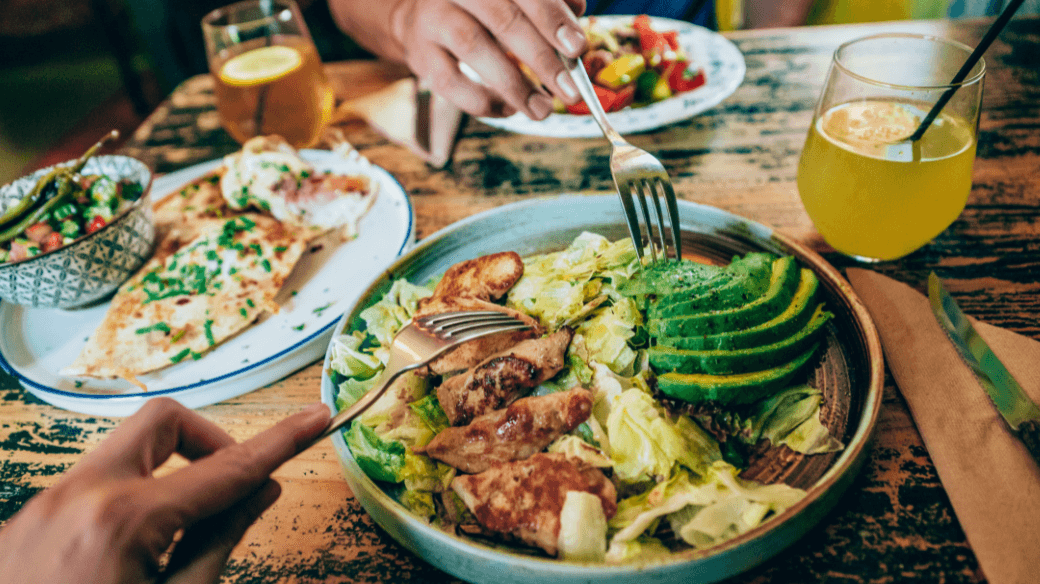How Does Healthy Eating Help Me Manage Diabetes?
&srotate=0)
Whether you’re living with diabetes or know somebody who is, practicing healthy eating can help make diabetes management easier! A great example of this is portioning your meals, which means watching the balance of your plate’s foods as well as how much you serve. The goal of healthy eating isn’t to take away your favorite foods, it’s to cheat smart!
How Meals & Diabetes Go Hand-In-Hand
Diabetes is a condition that can be influenced by how you eat. Eating smaller portions is a great way to control your diabetes without having to stop eating your usual foods. Some key points to balancing your plate include protein-heavy and fiber-rich meals that have white meat. There are many ways to portion out your plate in a way that fits the diabetic diet, but why is portioning so important?
Portioning out your plate can help manage your weight, which helps control your calorie intake and blood sugar levels. According to the CDC, losing weight can help make your blood sugar levels easier to manage. Other benefits include less medication, more energy, and better sleep. Remember that weight loss doesn’t have to be the goal – staying in a healthy weight range is also a great step forward.
Focusing on your calorie intake and keeping your carbohydrates consistent are a big part of portion control. An often-used approach is the hand method, where we plan out our plates using different parts of our hand to measure it. The hand method is often used to help visualize what your plate will look like without measuring with cups or liters! Below is a quick list to look over how each measurement works!
&srotate=0)
One Thumb: Fats like butter, oil, and other spreads. Try ingredients like margarine, olive oil, and hummus.
One Fist: Grains like brown rice, oats, and quinoa. It’s also good for fresh fruit like banana, guava, or berries.
One Cupped Hand: Legumes like chickpeas, beans, and nuts. Great ones to highlight are lentils, pinto beans, and almonds.
One Palm: Proteins like chicken, turkey or fish – you will want red meat smaller! Plant-based proteins, in moderation, work well. These include split peas, lentils and different beans.
Two Palms: Raw vegetables, especially leafy greens, like spinach, artichoke, and cauliflower.
What works great about the hand method is the easy to measure use of your thumb, palms, and fists to portion out your plates. This portioning also matches with the usual conventional measurements, like a fist of vegetables equaling a cup. Hand measuring also scales with the person’s size, letting those meal servings not go too big or too small.
Want to find some great meals to make with the new hand method you just learned? Try visiting the Diabetes Food Hub, a website by the American Diabetes Association, that has dozens of recipes fitting your needs and likes!
What Else Can I Do?
While portioning out your meals is a great way to manage your diabetes, there’s plenty of other tips to have a healthy relationship with food!
- Pack Healthy Shelf Snacks: Whether you’re going on vacation or for a walk, try packing healthy “shelf-friendly” snacks that won’t expire. Think mixed nuts, chickpea puffs, whole-grain crackers and dried edamame. These help to keep your hunger at bay while promoting high-fiber, low-sugar foods.
- Time Your Meals Every Day: One of the most effective ways of managing your blood sugar is spacing out your meals. Remember to eat breakfast early, keep your mealtimes consistent, and to allow time (4-5 hours) between meals for your blood sugar to lower.
- Holiday-Proof Your Meals: Thanksgiving and Christmas can bring disruption to your blood sugar with their bigger meals. Try bringing your own diabetes-friendly dish to share and put on your plate! If you do take from the holiday potluck, try serving yourself a little less than your family and friends to watch your blood sugar.
- Remember Cultural Foods Can Still Work: You don’t have to lose your favorite home meals when eating to keep your diabetes in check. Try swapping refined flour with whole grain flour to make tortillas or arepas. Choose dishes that have lean poultry or fresh seafood like ceviche. You can even swap sour cream for nonfat Greek or plain yogurt instead.
- Consider What Sugars Go On Your Plate: There are “good” and “bad” sugars for diabetes. Remember that natural sugars found in fruits are better than processed sugar found in snacks or desserts. Even when eating fruits (like mangoes or berries), be sure to keep them in moderation to not let your blood sugar spike. Talk with your doctor to find the right serving size for you.
Remember to ask your doctor any questions about nutrition, medicine and managing your diabetes. Creating a plan for your meals – whether it’s portioning, timing or cooking – can make a world of a difference for your blood sugar. Set goals for yourself and start small: health is a journey, not a race!
To find out more about how Health Services of North Texas can help you manage your diabetes, visit our diabetes management page.